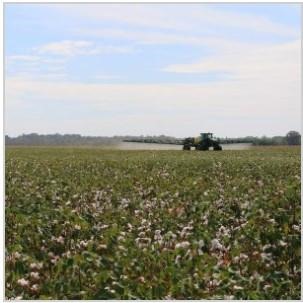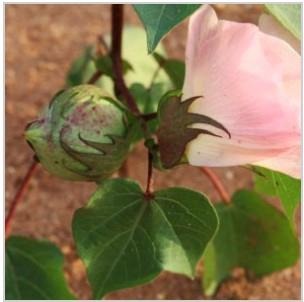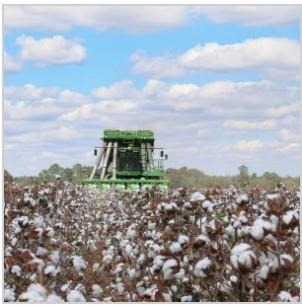There is nothing more sustainable or more down to earth than growing cotton in Alabama, according to Alabama Cooperative Extension System Cotton Agronomist Steve Brown. The cotton plant is still growing in much the same way as it did 200 years ago. The crop’s resilience throughout history has earned it a reputation for sustainability and secured a permanent rotation in the state.
It’s true that Alabama’s climate suits the needs of the cotton plant. Still, seed technology advancements, improved crop management practices and more than 100 years of research at Auburn University have laid a firm foundation for Alabama’s cotton producers as they continually seek to produce high-quality cotton.
Cotton Production History
Brown, who is also an assistant professor in Auburn University’s crop, soil and environmental sciences department, said the physical cotton seed has undergone a lot of changes in the last 30 years. From seed saving to bioengineered seed, cotton farmers are planting a different seed than they were many years ago.
In the early 1900s, synthetic fertilizers became available. Then, in the mid-1900s, crop protection chemicals (pesticides) were introduced. This enabled producers to gain the upper hand on major cotton pests.
Golden Era of the Seed
Brown said an era of growth and a major productivity shift are two defining factors in the past three decades.
“Twenty-five years ago, we entered the golden age of the cotton seed, as insect protection and novel weed management options were added to the seed’s DNA,” Brown said. “Biotechnology came to the forefront and allowed us to do a much better job on key insect pests and to consistently, efficiently deliver reliable weed control. The eradication of the boll weevil from Alabama by the mid-1990s also greatly contributed to the sustainability of cotton in our state.”
Brown said biotechnology in the seed has revolutionized what can happen on the farm.
“Our yield possibilities have gone from 600 or 700 pounds per acre to 1,500 pounds and acre—and occasionally more,” he said.



Importance of Cotton Seed Technology
Cotton seed has become increasingly important in the last few decades.
“Insect and weed control are built in, so the price of a bag of seed has gone from $30-$35 in the mid-1990s to close to $700 per bag in 2022,” Brown said. “Seed quality, seeding rates and helping producers get the most for their money are extremely important.”
He said for this reason, he and other Alabama Extension and industry professionals are doing a lot of research related to seed quality, seeding rates and the seed itself. In terms of a value for the environment, Brown said the new technologies have reduced insecticide use in cotton.
“We’ve gone from situations where we sprayed insecticides up to 10 or 20 times—many years ago—to now when producers spray maybe two times,” Brown said. “These are very environmentally friendly changes that not everyone is aware of when they look at a field of cotton.”
Ongoing Cotton Research
There is a wide array of sophisticated cotton research that is ongoing, covering a broad range of disciplines.
“We continue to evaluate varieties, genetics, insect and weed control,” he said. “Nitrogen and fertility issues are also at the forefront of our research. Just this year, we’ve seen fertilizer prices increase three-fold globally. Finding ways to help farmers be more efficient and use resources effectively is imperative.”
A current research topic focuses on increasing row spacing. While this is a new concept, it may be an option to help farmers lower plant stress levels and be more efficient and cost-effective with input applications. A 30- to 40-inch row is most common. However, there are researchers across the U.S. working with different row spacing intervals to determine the most efficient row spacing for modern cotton crops.
The Old Rotation
Auburn University is home to The Old Rotation. The Old Rotation is the oldest cotton experiment in the world, with research spanning back 125 years.
“This demonstrates that cotton is, in fact, sustainable,” Brown said. “This field experiment was initiated to demonstrate the value of cover crops, as well as the importance of rotation. It is a very effective tool to help producers make management decisions based on real data.”
Another university-led demonstration is the Cullars Rotation. While not quite as long-standing as The Old Rotation, it has been maintained on the Auburn campus for 115 years. The Cullars Rotation serves as a teaching and research site for plant nutrient (fertilizer) deficiencies in cotton, corn and soybeans.
Prominent Changes, the Future of Cotton
“The current and most pressing challenge for 2022 is input costs,” Brown said. “Fertilizer prices have gone up three-fold while global issues have resulted in escalated prices and limited availability for many other ag inputs.”
Equipment and parts costs are also a big challenge for producers. However, one of the most prominent challenges is finding qualified labor.
“There is sophisticated technology associated with operating farm machinery, tractors and well as harvesters,” he said. “The newest cotton pickers lists for $1 million, but its mechanisms and computer aided controls allow for great efficiency. Modern farming operations include considerable sophistication and compels necessitate skilled, qualified and willing workers.”
Alabama cotton production would also benefit from more rainfall or improved irrigation accessibility implementation.
Brown said only approximately 10 percent of row crop land in Alabama has irrigation. He also said much of the state would benefit from an expansion of the capacity to water crops. Alabama receives ample rainfall, but the timing is sometimes less than ideal. Accessibility of water resources for irrigation is a great need in many parts of Alabama.
“If we could wave a magic wand and make irrigation widely available, there would be a tremendous boon to the state’s overall economy,” he said. “Unfortunately, water resources are not easily accessible for all farmers and the installation of irrigation is often cost prohibitive. But if we could tap some of the water resources in Alabama, we could certainly increase yields and it would be a great bonus to Alabama agriculture.”
Alabama Cotton Shorts
Learn more about cotton production and research by visiting www.aces.edu. Subscribe to Brown’s monthly newsletter, Alabama Cotton Shorts, to stay up-to-date on cotton happenings in the state.
Down to Earth: Agriculture Sustains Alabama
Alabama Extension is getting Down to Earth. Why? Because agriculture sustains Alabama. Whether your ag experience is in the grocery store, in the classroom or as your profession—Extension has a resource for you.
We are proud to be partnering with the Alabama Agribusiness Council, the Alabama Cattlemen’s Association, the Alabama Department of Agriculture and Industries, the Alabama Farmers Federation, the Alabama Poultry and Egg Association, the Alabama Forestry Commission, Sweet Grown Alabama and the Alabama Association of RC&D Councils.
Source : aces.edu